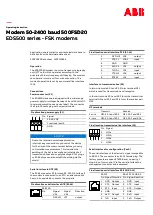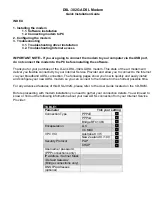
5. Operation and Maintenance
5-40
August 2001
9123-A2-GB20-20
FTP File Transfers
The
FrameSaver unit supports a standard File Transfer Protocol (FTP) server over
Transmission Control Protocol (TCP). A complete binary image of the
configuration files can be copied to a host to provide a backup. To use this feature,
the unit must be configured to support Telnet and FTP Sessions.
Using this feature, you can transfer configuration files
to/from
a FrameSaver node,
program files
to
a FrameSaver node, and User History data
from
a FrameSaver
node through a user data port or the network interface using a management PVC,
or through the COM port.
Be aware of the following rules when doing a file transfer:
You must have Access Level 1 permission to use the put and get commands.
However, you can retrieve the data file for the user history reports regardless
of access level.
You cannot put a configuration file to the factory.cfg or current.cfg files under
the system directory. Configuration files should be put to a customer file
(cust1.cfg or cust2.cfg), then loaded into the downloaded unit’s Current
Configuration via the menu-driven user interface.
You can only put a NAM program file (nam.ocd) into a FrameSaver unit. You
cannot get a program file from the FrameSaver unit to a host.
Before putting a download file, you must use the bin binary command to place
the data connection in binary transfer mode.
When transferring SLV user history information to the NMS, you can only get a
uhbcfull.dat file. It is recommended that you use the NMS application to get
this information (see
A data file (uhbcfull.dat or lmitrace.syc) cannot be put into a FrameSaver
node.
LMI packet capture data (lmitrace.syc) is not readable when the LMI Packet
Capture Utility is active.
The SLV user history file is only available to units with the FLEX SLV
feature set.
FrameSaver SLV units provide an additional feature that allows new software to be
downloaded in the background, using the selected bandwidth and without
interfering with normal operation. Downloads can be performed quickly, using the
full line speed, or at a slower rate over an extended period of time.
You initiate an FTP session to a FrameSaver node in the same way as you would
initiate an FTP to any other IP-addressable device.
NOTE:
Loading a configuration with many DLCIs from a unit’s Customer
Configuration 1 or 2 option area into its Current Configuration area may take
time. Allow a minute or more for the downloaded file to be put into the unit’s
currently active configuration.
Содержание FrameSaver FLEX 9123
Страница 1: ...FrameSaver FLEX 9123 User s Guide Document No 9123 A2 GB20 20 August 2001 ...
Страница 10: ...Contents viii August 2001 9123 A2 GB20 20 ...
Страница 24: ...1 About the FrameSaver FLEX 9123 1 10 August 2001 9123 A2 GB20 20 ...
Страница 34: ...2 User Interface and Basic Operation 2 10 August 2001 9123 A2 GB20 20 ...
Страница 98: ...3 Configuration 3 64 August 2001 9123 A2 GB20 20 ...
Страница 194: ...7 Setting Up OpenLane for FrameSaver Devices and Activating SLV Capability 7 10 August 2001 9123 A2 GB20 20 ...
Страница 212: ...8 Setting Up NetScout Manager Plus for FrameSaver Devices 8 18 August 2001 9123 A2 GB20 20 ...
Страница 228: ...A Menu Hierarchy A 6 August 2001 9123 A2 GB20 20 ...
Страница 258: ...B SNMP MIBs and Traps and RMON Alarm Defaults B 30 August 2001 9123 A2 GB20 20 ...
Страница 266: ...C Connectors Cables and Pin Assignments C 8 August 2001 9123 A2 GB20 20 ...
















































